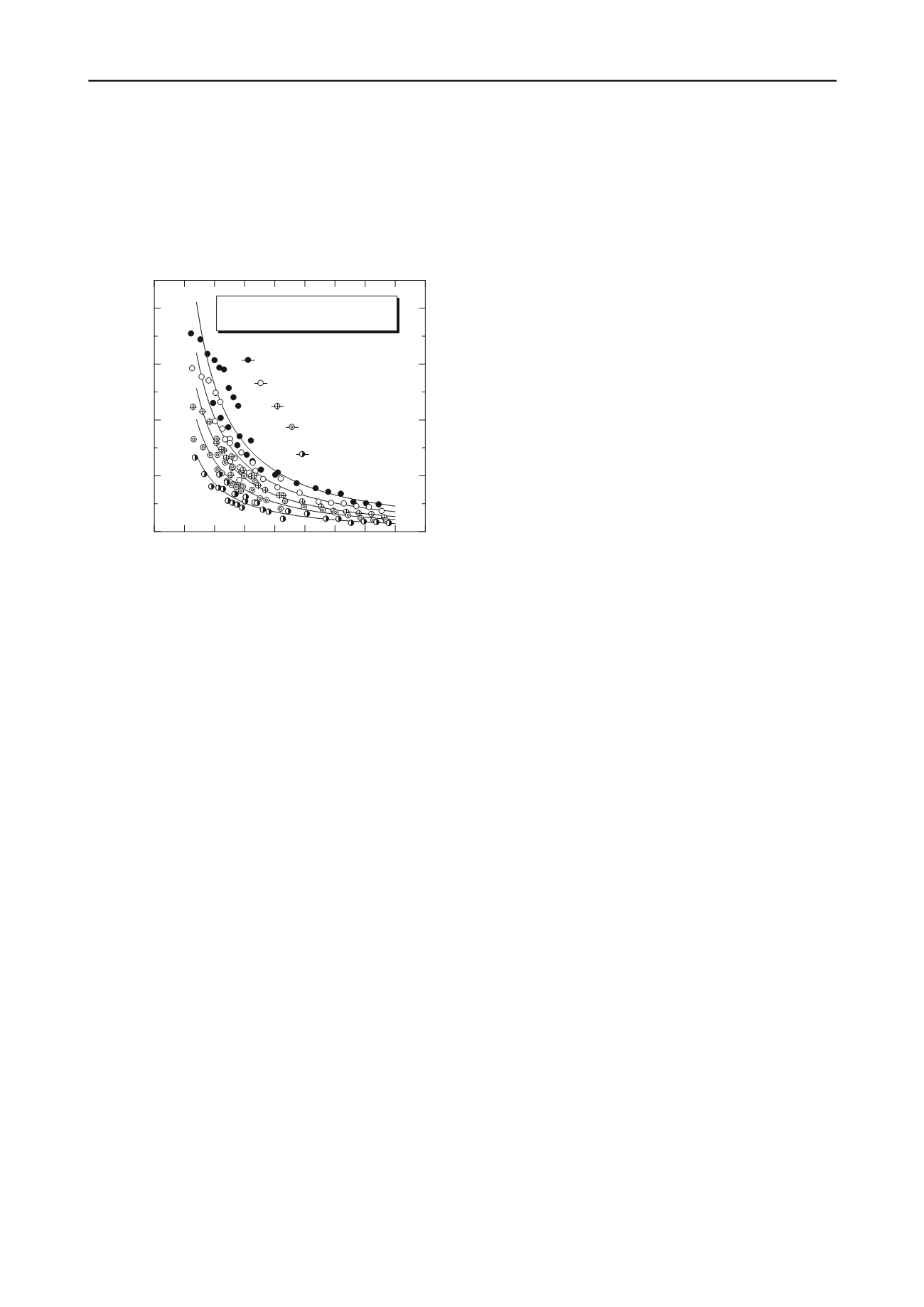
348
Proceedings of the 18
th
International Conference on Soil Mechanics and Geotechnical Engineering, Paris 2013
Proceedings of the 18
th
International Conference on Soil Mechanics and Geotechnical Engineering, Paris 2013
for cemented non- to low-swelling clays (Horpibulsuk et al.,
2011b). It was suggested to take the
B
-value as 1.27 for the
cemented non- to low-swelling clays (Horpibulsuk et al., 2011a,
b and 2012a). To employ Eq. (2) for assessing the strength of
any lightweight cemented clay at different void/cement ratios
(air content and cement content), the parameters
A
and
B
must
be predetermined. This task can be achieved by a back-
calculation of at least two trial strength data.
7 REFERENCES
Gibson R.E. and Henkel D.J. 1954. Influence of duration of tests at
constant rate of strain on measured “drained” strength.
Géotechnique
4 (1), 6-15.
Darcy H. 1856.
Les fontaines publiques de la ville de Dijon
. Dalmont,
Paris.
Abrams D.A. 1918. Design of Concrete Mixtures. In: Structural
Materials Research Laboratory, Lewis Institute, Chicago, Bulletin
1, 20p.
Chinkulkijniwat A. and Horpibulsuk S. 2012. Field strength
development of repaired pavement using the recycling technique.
Quarterly Journal of Engineering Geology and Hydrogeology
45
(2), 221-229.
0 5 10 15 20 25 30 35 40 45
0
500
1000
1500
2000
Lightweight cemented Bangkok clay
7 days of curing
q
u(
w
=136%)
=23897/(
V/C
)
1.26
|r|=0.937
q
u(
w
=157%)
=18533/(
V/C
)
1.26
|r|=0.954
q
u(
w
=178%)
=15818/(
V/C
)
1.29
|r|=0.966
q
u(
w
=199%)
=12051/(
V/C
)
1.28
|r|=0.943
q
u(
w
=241%)
=8373/(
V/C
)
1.29
|r|=0.933
Void/cement ratio,
V
/
C
Unconfined compressive strength,
q
u
(kPa)
Consoli N.C., Foppa D., Festugato L. and Heineck K.S. 2007. Key
parameters for strength control of artificially cemented soils.
Journal of Geotechnical and Geoenvironmental Engineering
ASCE
133 (2), 197-205.
Horpibulsuk S. and Miura N. 2001. A new approach for studying
behavior of cement stabilized clays.
Proc. 15
th
International
Conference on Soil Mechanics and Geotechnical Engineering
(ISSMGE). Istanbul, Turkey, Vol. 3, 1759-1762.
Horpibulsuk S., Miura N. and Nagaraj T.S. 2003. Assessment of
strength development in cement-admixed high water content clays
with Abrams’ law as a basis.
Géotechnique
53 (4), 439-444.
Horpibulsuk S., Bergado D.T. and Lorenzo G.A. 2004. Compressibility
of cement admixed clays at high water content.
Geotechnique
54
(2), 151-154.
Horpibulsuk S., Miura N. and Nagaraj T.S. 2005. Clay-water/cement
ratio identity of cement admixed soft clay.
Journal of Geotechnical
and Geoenvironmental Engineering
ASCE 131 (2), 187-192.
Figure 6. Analysis of strength development in lightweight cemented
Bangkok clay using
V
/
C
.
Horpibulsuk S., Katkan W., Sirilerdwattana W. and Rachan R. 2006.
Strength development in cement stabilized low plasticity and coarse
grained soils: Laboratory and field study.
Soils and Foundations
46
(3), 351-36.
5 CONCLUSIONS
Based on this study, it is brought out that the void/cement ratio
is the prime parameter for analysis of strength and deformation
behavior of lightweight cemented clays with non- to high
swelling potential. This parameter takes into account the
influence of both clay fabric reflected by the air volume and the
level of cementation. The conclusion can be drawn as follows.
Horpibulsuk S., Liu M.D., Liyanapathirana D.S. and Suebsuk J. 2010.
Behavior of cemented clay simulated via the theoretical framework
of the Structured Cam Clay model.
Computers and Geotechnics
37,
1-9.
Horpibulsuk S., Rachan R. and Suddeepong A. 2011a. Assessment of
strength development in blended cement admixed Bangkok clay.
Construction and Building Materials
25 (4), 1521-1531.
1. For a given soft clay at a particular water content, the
cementation bond strength increases as void/cement ratio,
V/C
decreases. Consequently, the yield stress in K
0
-consolidation
and compressive strength increases with the decrement of
V
/
C
.
The stress-strain response and compression characteristics in
pre-yield state are practically the same as long as the
V/C
value
is identical.
Horpibulsuk S., Rachan R., Suddeepong A. and Chinkulkijniwat, A.,
2011b. Strength development in cement admixed Bangkok clay:
laboratory and field investigations.
Soils and Foundations
51 (2),
239-251.
Horpibulsuk S., Phojan W., Chinkulkijniwat A., and Liu M.D. 2012a.
Strength development in blended cement admixed saline clay.
Applied Clay Science
55, 44-52.
2. Based on the void/cement ratio and Abram’s law, a
relationship between strength, void/cement ratio for a particular
water content and curing time (Eq.2) is proposed. The
relationship is useful in estimating the laboratory strength
wherein air content and cement content vary over a wide range
by a few trial tests. It also facilitates the determination of proper
quantity of cement to be admixed for different air contents to
attain the target strength. The formulation of the proposed
relationship is on sound principle and developed from distinct
clays (non- to high swelling clays). The
A
and
B
values can be
determined by a back-analysis of at least two trial strength data.
It is thus possibly applicable for various clays.
Horpibulsuk, S., Suddeepong, A., Chinkulkijniwat, A., and Liu, M.D.
2012b. Strength and compressibility of lightweight cemented clays.
Applied Clay Science
69, 11-21.
Liu M.D. and Carter J.P. 1999. Virgin compression of structured soils.
Géotechnique
49 (1), 43-57.
Liu M.D. and Carter J.P. 2000. Modelling the destructuring of soils
during virgin compression.
Géotechnique
50 (4), 479-483.
Liu M.D. and Carter J.P. 2002. Structured Cam Clay Model.
Canadian
Geotechnical Journal
39 (6), 1313-1332.
Miura N., Horpibulsuk S. and Nagaraj T.S. 2001. Engineering behavior
of cement stabilized clay at high water content.
Soils and
Foundations
41 (5), 33-45.
Suebsuk J., Horpibulsuk S. and Liu M.D. 2010. Modified Structured
Cam Clay: A constitutive model for destructured, naturally
structured and artificially structured clays.
Computers and
Geotechnics
37, 956-968.
6 ACKNOWLEDGEMENTS
This work was supported by the Higher Education Research
Promotion and National Research University Project of
Thailand, Office of Higher Education Commission. The
financial support and facilities that were provided by the
Suranaree University of Technology were appreciated.
Suebsuk J., Horpibulsuk S. and Liu M.D. 2011. A critical state model
for overconsolidated structured clays.
Computers and Geotechnics
38, 648-658.


